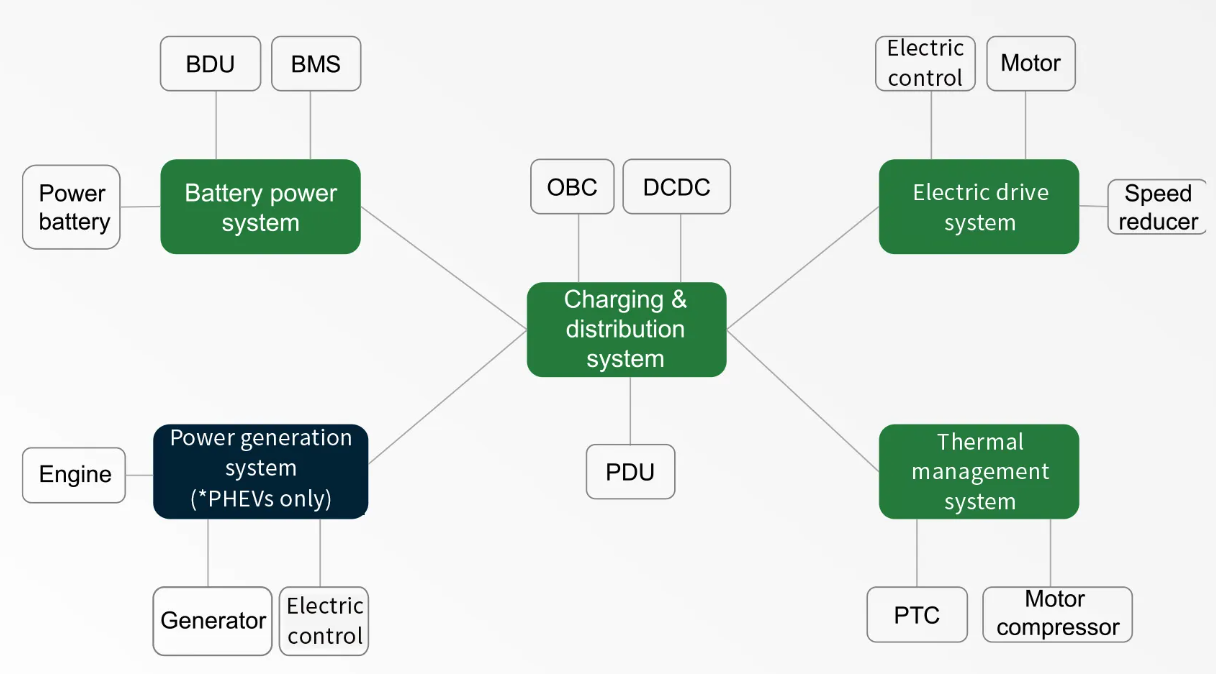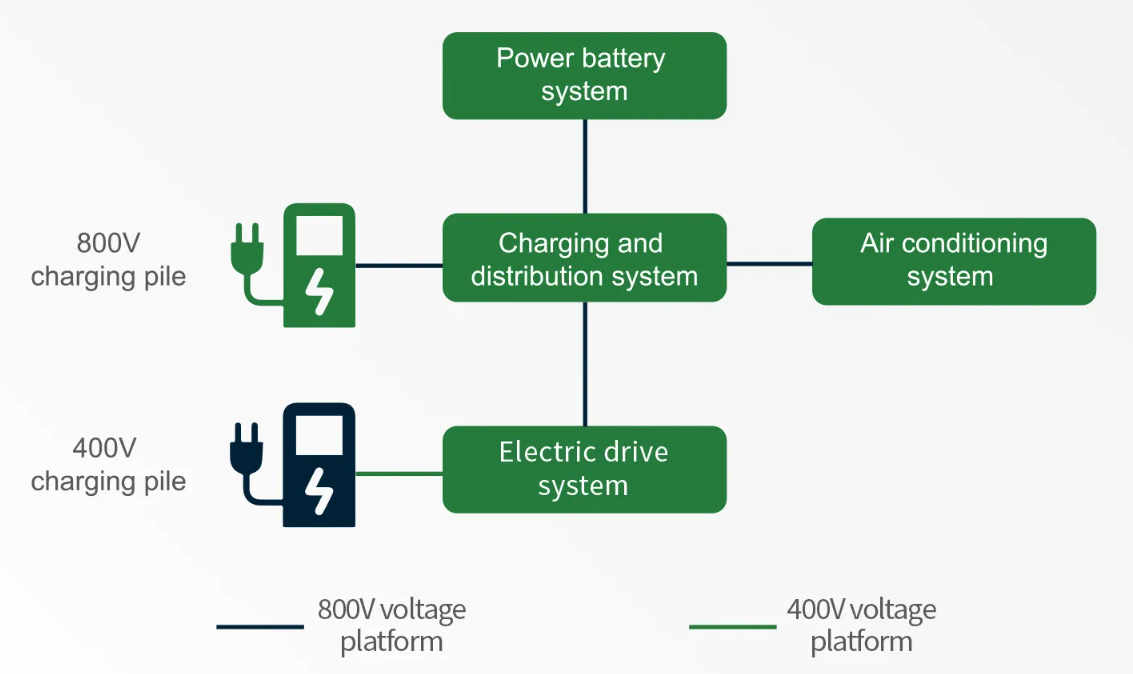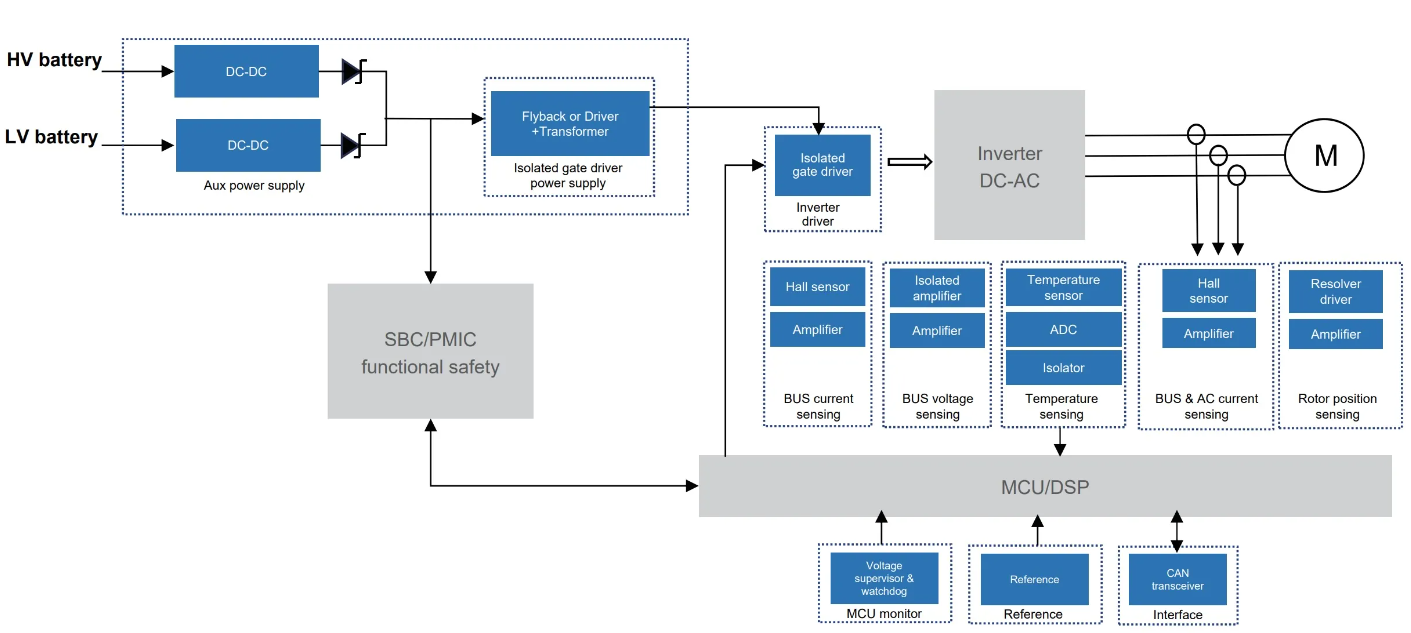
Electrification is reshaping the auto industry. Electric vehicles (EVs) not only require extensive use of batteries to provide energy, but also extensive use of power electronics to charge battery storage, make the most efficient use of electricity and collect energy from braking, among other opportunities to extend battery life. The shift from internal combustion engines (ICE) to electric traction requires not only a wider range of power electronics, but also devices capable of operating at much higher voltages than those used in the past.

Figure 1: NEV high-voltage architecture
Upgrade of New Energy Vehicles (NEVs) High-voltage Architecture
The electric system of an electric vehicle extends to all parts of the vehicle, with the charging and distribution system shown in Figure 1 supplying power to the battery when the vehicle is connected to the main power source. In motion, the charging and distribution system provides energy to the electric drive system and electric motors, as well as other subsystems such as thermal management. Early electric cars used 400V power rails to connect these subsystems. However, the trend is now towards 800V platforms to take advantage of fast charging technology and the higher efficiency of the high torque or high speed of the drivetrain at this voltage level. Market research suggests that car sales based on the 800V architecture will reach around 1 million units by the beginning of 2025 and double by the end of 2025.
There are two key advantages behind the move to 800V. One is that at 800V, the battery can be charged faster, which alleviates people's concerns about the vehicle's driving range and charging time. A further advantage is that the 800V platform has lower energy consumption at high power output levels, which increases the effective range.
There are several upgrade options for the 800V platform. In order to ensure the voltage stability and uniformity of the whole system, the use of whole system high voltage is the development trend. In addition, in order to be compatible with the existing 400V platform DC charging pile, a booster unit was added, the most common booster unit today is integrated into the electric drive system and uses the same power unit as the motor controller, thus helping to reduce costs.

Figure 2: A booster unit enables compatibility with existing 400V platforms
Current Situation and Technological Trends of Main Inverter Controller
At the same time, in order to meet market demand, electrical subsystems must be manufactured at a low cost while providing high performance, small size and low weight. These requirements have led to a trend towards a higher level of integration of motors, controllers, reducers and other components. Thanks to component integration, enclosures and accessories as well as high-voltage cables can be saved. Integration also tends to improve electromagnetic compatibility (EMC) and requires less shielding overall.
There are several levels of integration. An integrated electric drive system represents a 2-in-1 integration of a motor and a controller or motor. This evolved into a 3-in-1 design with integrated motor, controller and reducer architecture that eventually fits all of them in one housing.

Figure 3: Integrated motor, controller, and speed reducer structure
The traction inverter consists of a low-voltage control unit and a high-voltage power supply stage. Low-voltage control units include motor control units (MCUS), CAN transceivers, gate drivers, signal detection circuits, SBC/PMIC, or some power supply circuits. The high voltage power supply level mainly consists of power supply devices, such as power modules or discrete devices. In order to ensure the safety of high and low voltage, the isolation chip with enhanced insulation must be used between the low voltage control unit and the high voltage power supply stage.

Figure 4: Isolation of gate-driver circuitry in an MCU-based environment
High-integrated isolation solution
The Optical is widely used in the industrial market due to its low-cost characteristics, but it is relatively rare in automotive applications due to its light decay problem. Capacitive isolation takes advantage of the coupling effects encountered with electrical fields to pass signals across an insulator. It utilizes semiconductor process technology, eliminating the light decay problem. Digital isolators can not only reduce size through multi-channel integration but also offer higher CMTI and longer life, making them widely used in automotive applications.
The digital nature of capacitive isolation allows for the use of noise-suppression techniques to prevent voltage spikes from disrupting sensor inputs to high-frequency control processors. NOVOSENSE Microelectronics, for example, uses an adaptive form of on-off keying (OOK) to handle communication between the two sides of its capacitive-isolation devices. By adapting to noise generated on the high-voltage side, the protocol can achieve high immunity to common-mode transients that can prove troublesome to traditional isolation components. NOVOSENSE’s isolation technology can achieve common-mode transient immunity as high as 200kV/µs.
Because capacitive elements can easily be integrated into single ICs, this form of coupling delivers high isolation protection for multiple channels within the same package and at high communication rates. This, in turn, supports the high channel counts needed in automotive designs. The technology also supports the integration of other functions, such as the gate drivers used to control power transistors.
Isolated gate driver is a key component of traction inverter and OBC systems. Especially in traction inverter applications, functional safety is needed, and it also needs higher CMTI to deal with complex system environments. In an 800V platform, dv/dt is larger, which will affect the EMI of the system; therefore, a good drive design can reduce dv/dt to optimize EMI. NSI6602 made by NOVOSENSE can provide, 5700Vrms isolation in SOP16 (300mil) or SOP14 (300mil) package. Its system robustness is supported by 150kV/us typical common-mode transient immunity (CMTI). As a result, it is widely used in the OBC system.
Current and voltage sampling is essential to maintain the normal operation of the system. They can be achieved by using an isolated amplifier and a Hall current sensor. The isolated amplifier is an operational amplifier (op amp) with galvanic isolation, such as NSI1311 made by NOVOSENSE, which is widely used for isolated current sensing in traction inverter and OBC applications. This includes high CMTI to ensure that the component can provide accurate and reliable measurement results, even when working alongside the high-power switches encountered in traction inverter applications. The Hall current sensor, which can detect the magnetic field generated by carriers using the Hall effect, can deliver high accuracy, with output errors of 2% maximum and with non-linearity of just 0.2%. In the case of Hall effect sensors made by NOVOSENSE, the maximum bandwidth can be 2MHz.
Similarly, the interface circuitry needed for CAN connectivity provides another opportunity for integrated isolation. Examples are the NSI1050 and NSI1042-Q1 from NOVOSENSE. The NSI1050 combines a two-channel isolator based on capacitive technology, providing up to 5kVrms of protection, with a CAN transceiver able to support data rates up to 1Mb/s. The NSI1042-Q1 increases the maximum data rate to 5Mb/s and can be provided in a form that satisfies the stringent AEC-Q100 certification.

Figure 5: Block diagram of a drive and controller unit fed by two voltage rails
About US
Heisener Electronic is a famous international One Stop Purchasing Service Provider of Electronic Components. Based on the concept of Customer-orientation and Innovation, a good process control system, professional management team, advanced inventory management technology, we can provide one-stop electronic component supporting services that Heisener is the preferred partner for all the enterprises and research institutions.
